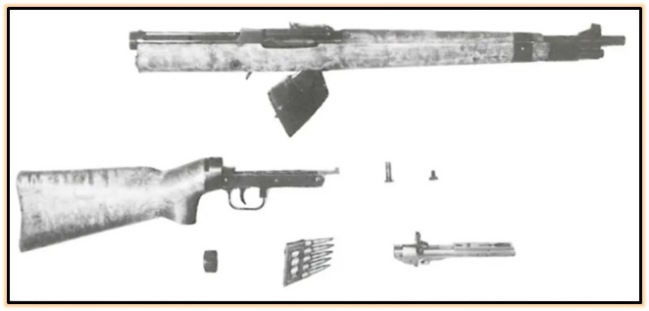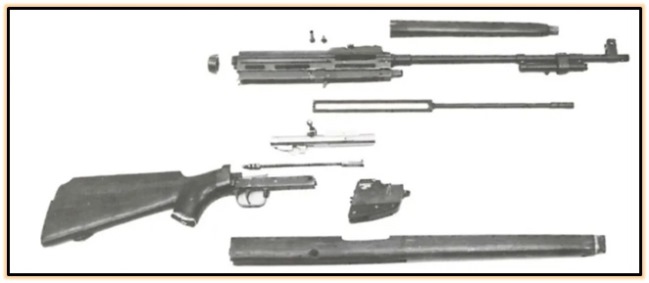The Lahti L-36 is a Finnish gas-operated semi-automatic rifle developed shortly before the outbreak of World War II. In October 1934, the Finnish Army’s chief small arms designer, Aimo Lahti, was commissioned to design a semi-automatic rifle. In 1936, he presented his first prototype, designated L-36

The Finnish military was not particularly enthusiastic when it came to this prototype, and for good reason. In retrospect, it is easy to see that the basic concept was correct – gas-operated action with a gas piston. But unfortunately, the rest of the rifle was far from a practical military weapon. The biggest drawback was the magazine, for which Lahti, for some strange reason, chose a Mannlicher-style design. In other words: the magazine was fixed (non-removable) and reloaded using clips that were an integral part of the magazine, which would not work without them. The L-36 magazine capacity was only 5 rounds. An even bigger problem was that it could not be loaded from the top, instead Lahti provided a hinge and a switch at the front of the magazine to swing the magazine out for reloading. Thus, to reload, the soldier had to turn the rifle upside down, open the magazine, insert a 5-round clip, close the magazine cover and put the rifle on safety by pulling back the lever on top of the rifle - not exactly easy, fast or convenient in combat. Another problem was the T-shaped lever used to cock the rifle - Lahti for some reason placed it on top of the weapon and gave it an awkward shape. The rifle weighed about 5 kg, although this would not have been a big problem if it had been otherwise practical and suitable for combat use

Unfortunately, the L-36 was inferior to its obvious contemporary competitor, the Soviet ABC-36 rifle (weighing 4.3 kg and having a conventional detachable box magazine for 15 rounds). Other negative factors were high production costs for which there was no funding, lack of possible production capacity, and mistrust of gas-operated weapons, which were still quite common among the Finnish military at that time
In 1939, the Finnish military remembered the almost forgotten project of a self-loading rifle, and this time the necessary funding had already been allocated. Aimo Lahti began developing an improved rifle design based on his earlier prototype L-36

The main improvement was the replacement of the old T-shaped cocking lever with a more typical rifle design of the bolt handle, and the sights and bolt mechanism were improved. However, it retained the awkward five-round Mannlicher magazine. The improved L-39 automatic rifle also had no chance of success. This was due to the Finnish-Soviet Winter War, which began in November 1939. During the war, the rather limited Finnish military industry was busy and did not have the necessary capacity to introduce new self-loading rifles into production. Only one prototype of the L-39 rifle was manufactured. When the Winter War ended in March 1940, the Finnish military had the opportunity to evaluate recent experience and it did not look favorable for self-loading rifles at all. Firstly, the Suomi M/31 submachine guns proved to be extremely useful and effective, so this weapon turned out to be a very good alternative to semi-automatic rifles. Secondly, Finnish troops also captured thousands of Soviet ABC-36 and SVT-38 rifles during the Winter War, which covered a pressing need for large quantities of semi-automatic rifles

During the temporary peace of 1940–1941, the Finnish military tested these two captured rifle models and decided to focus on the SVT-38 design due to its greater reliability and suitability for military use.